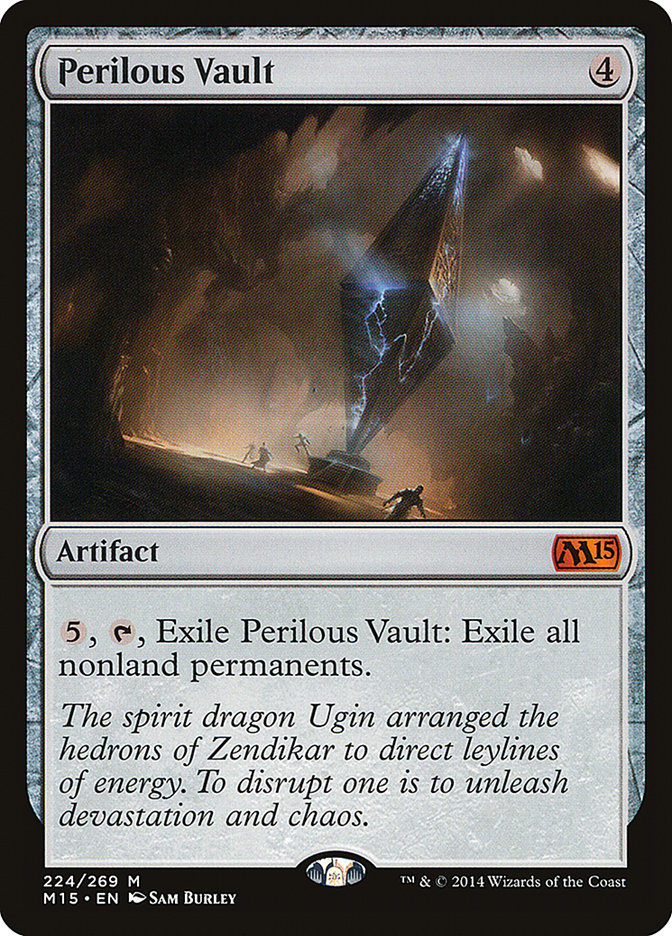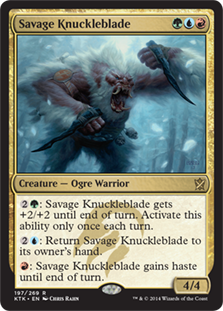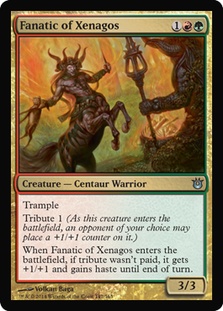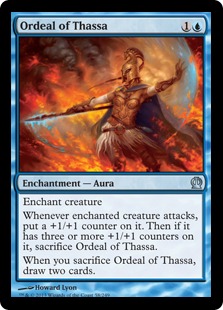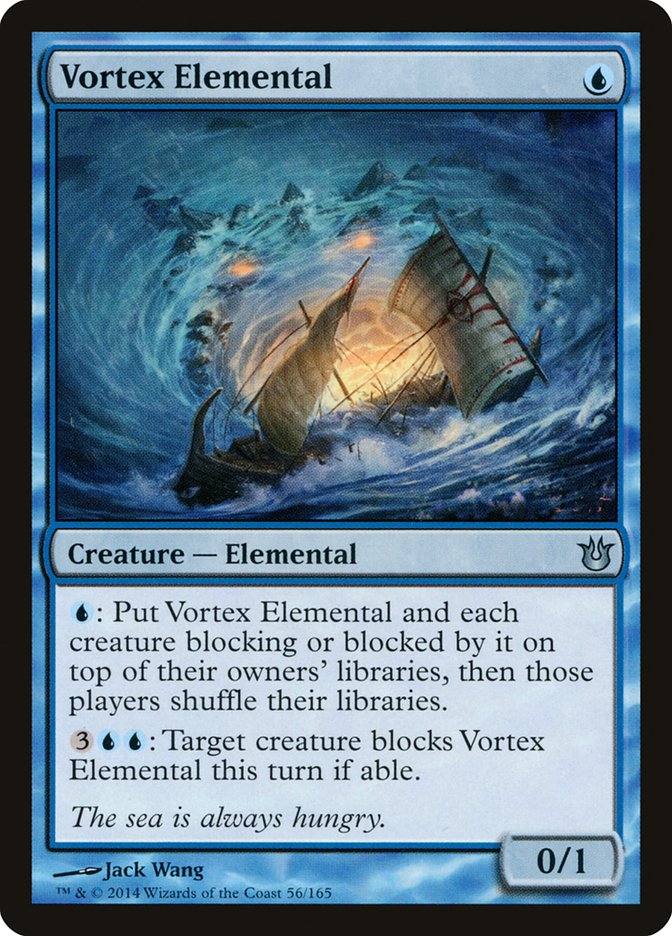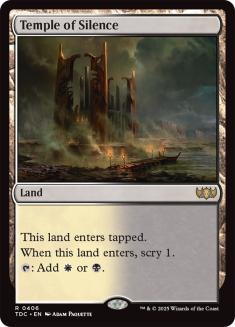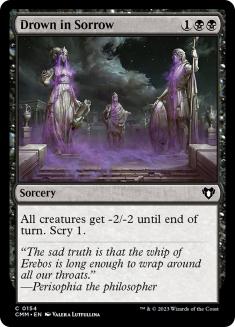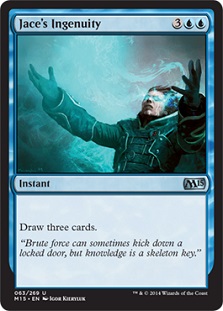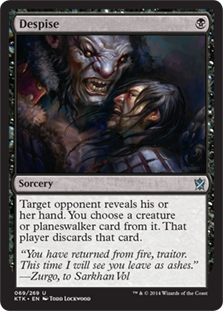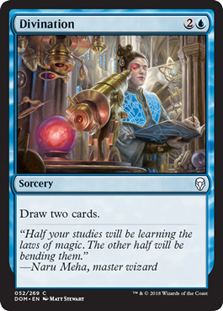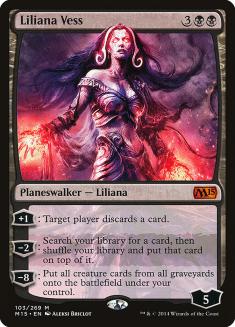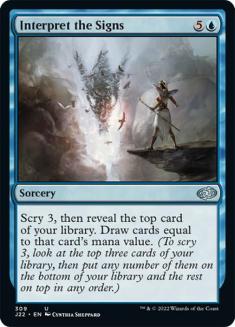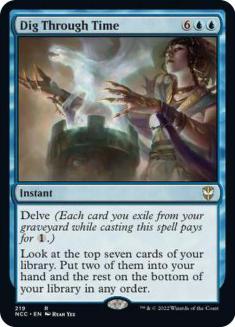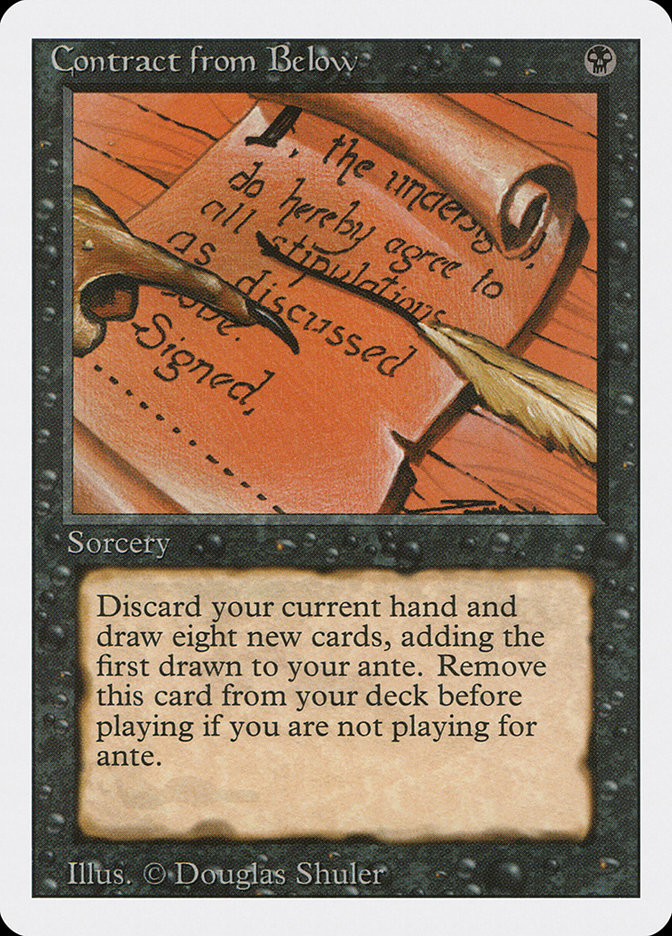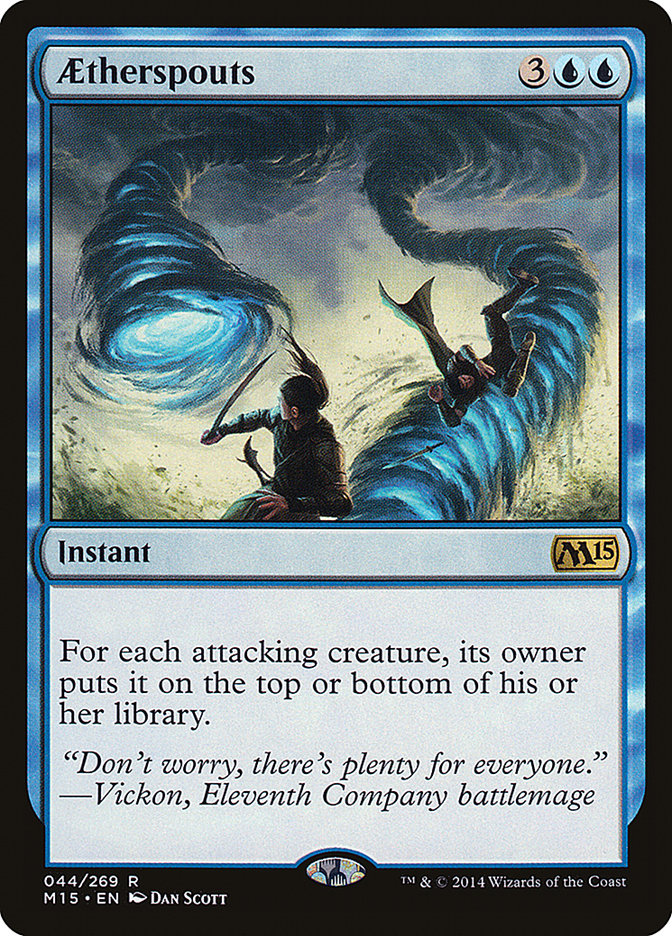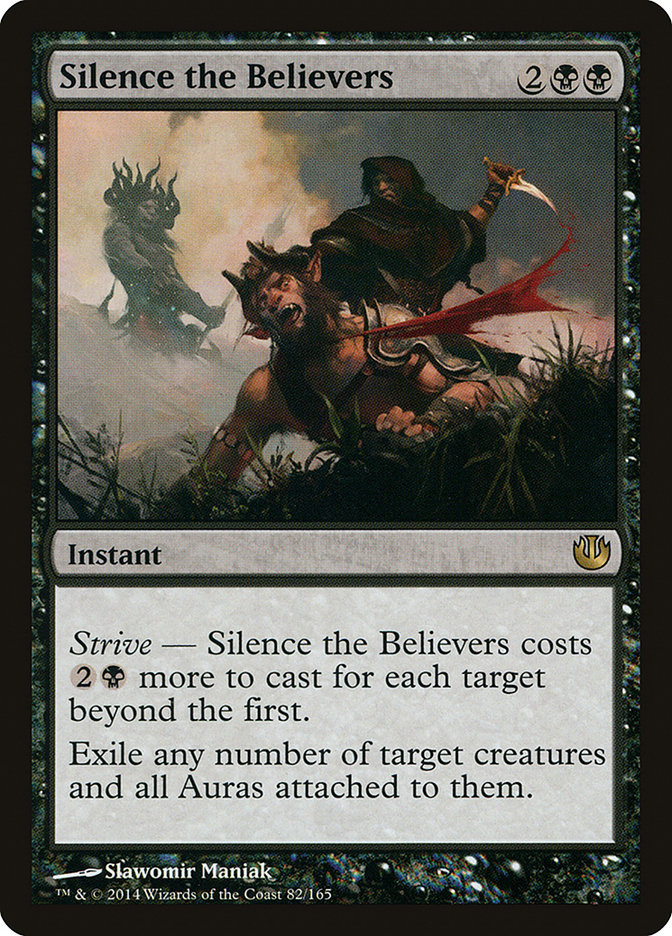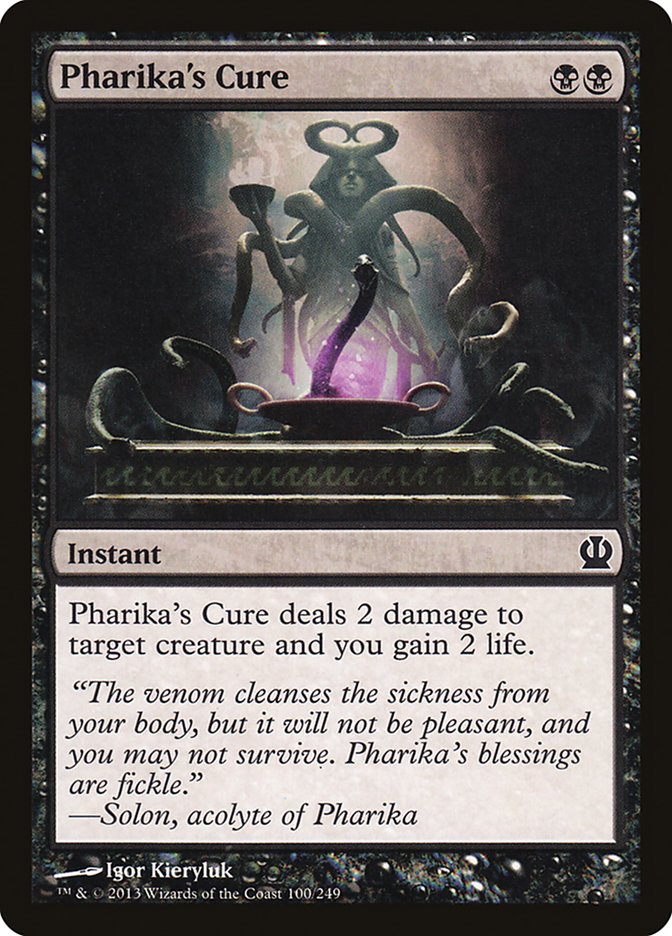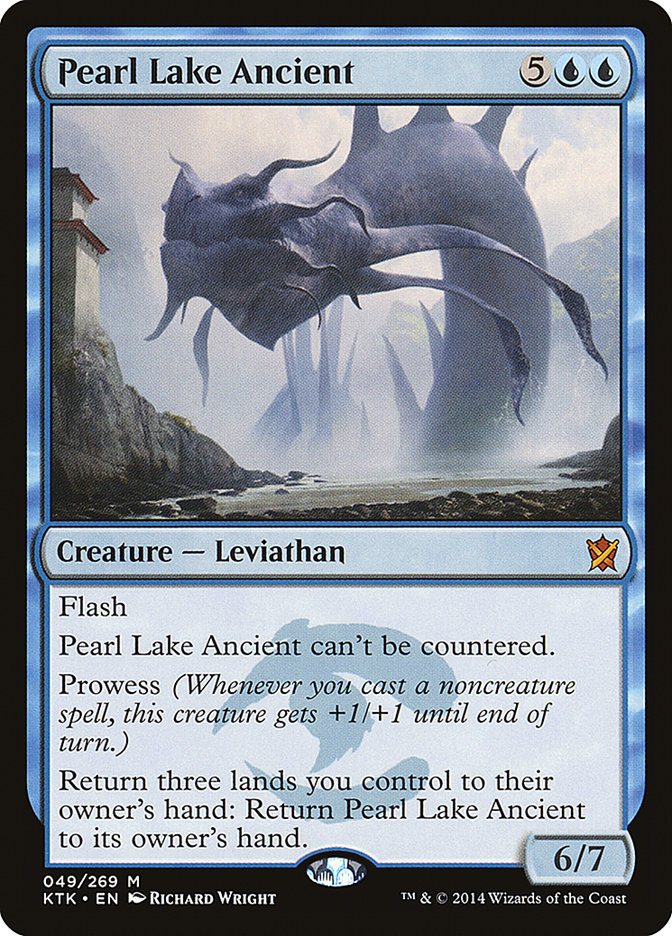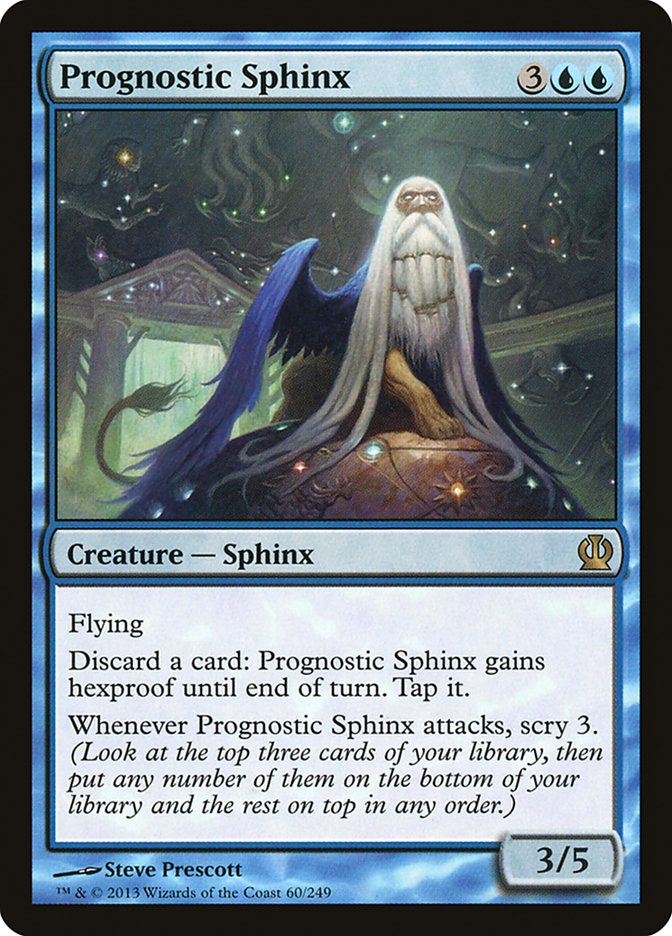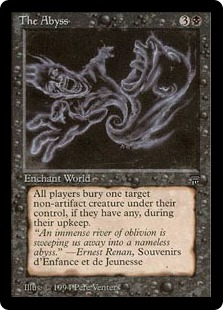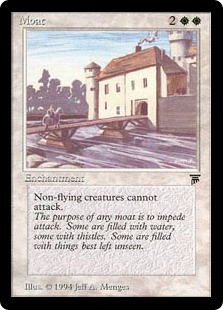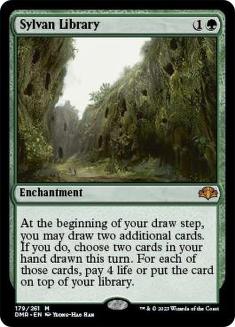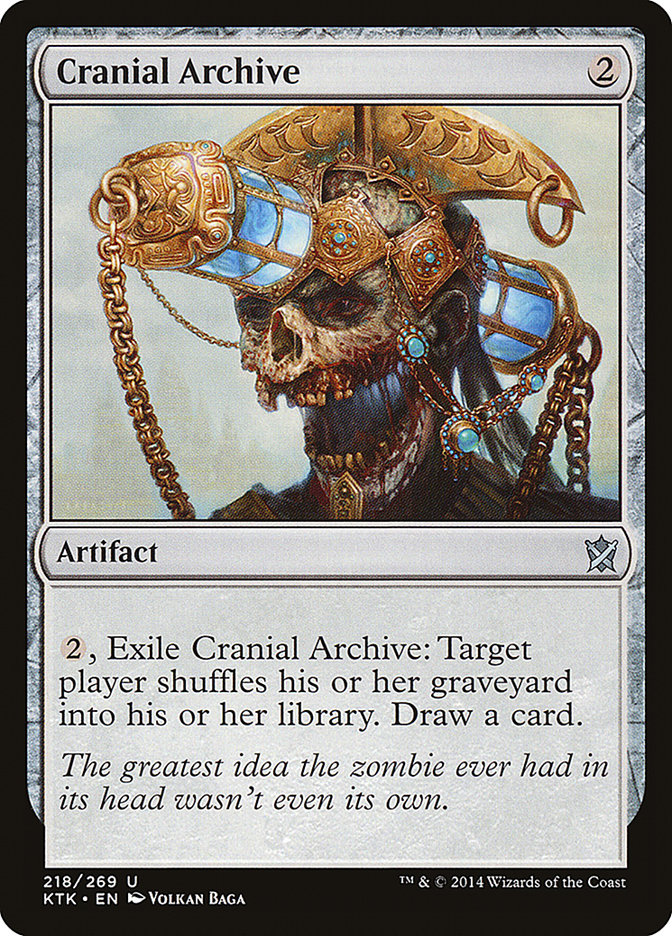I started out the year with a PTQ win.
Preamble
Midway through last year, I got third at
Grand Prix Chicago, requalifying for the Pro Tour for the first time in a few years. Magic means the world to me, and this was a huge deal. After
the event, I was so excited to be requalified – I’d put in a ton of work on the deck and really worked hard to get back into Magic shape. When I talked
about that aspect of things – the work – Craig Wescoe put it simply: “That’s what you did. And now you’re back.”
Barely missing the invite to the next Pro Tour was difficult,
and spending the next season trying to get the invite through the PTQ system was hard. I had a lot of close calls, but no cigars. I loved the
Khans of Tarkir Limited format though; I think it is one of the best Limited formats in some time. Madison put together something crazy like four or five
PTQ wins. I just never happened to be one of them.
I was excited for the Standard season to begin. I’ve basically been in love with my U/B Control deck since a few months before the Pro Tour. In
the current Standard, I fervently believe that this has been one of the best cards in the format since the format began:
Yes, it is slow, but even so, it is just so insanely powerful to take a hit from your opponent and force them to decide whether or not to add more to the
table. If they don’t, maybe you’ll blow up the world at the end of the turn, but if you don’t, it is usually because you don’t need to, and you
can afford the cost of more damage for the sake of going deeper into your deck. If you do have to blow up the world, being able to “get into
position” (untapping with no threats in play from your opponent) is just such an absurd position to be in.
One of the reasons I think U/B Control is the best deck in the format is this aspect. Basically, every deck with Siege Rhino feels like a great matchup.
Every deck with Whip of Erebos feels like a great matchup. When you start with those decks being the decks you are looking forward to playing against, it
is a recipe for success.
Challenges
That doesn’t mean it is all smooth sailing, however. Three fairly popular archetypes are absurdly difficult. I’ll give you a hint about what they are:
The worst matchup by far fortunately isn’t very popular: R/W Heroic combines the fast clock of the aggressive red deck, but like W/U Heroic, adds
pseudo-counterspells with Feat of Resistance and Gods Willing. W/U Heroic is also a bad matchup, but only a little bit; R/W Heroic has nearly as many
pseudo-counters, but it also has insane reach that W/U Heroic actually doesn’t. There is a moment versus W/U Heroic that if you make it through and
survive, you’re out of the woods. This is rarely true for R/W Heroic.
G/R Aggro was a matchup that I’d been struggling against again and again. It knocked me out of the running in more than one PTQ, basically on the strength
of a density of threats that feels endless. There is basically a point in playing against the deck where it feels as though literally every single non-mana
card matters. As many answers as you have, you don’t have infinite answers.
Temur is a problem because it has similar traits to both W/U Heroic (counters) and G/R Aggro (density of threats). In addition though, Savage
Knuckleblade is an intensely difficult card for U/B Control to deal with. Of these three decks, Temur was the biggest problem, and while I could beat any
of them, it wasn’t a great proposition.
Leading into the first PTQ of the year, I decided something had to give. W/U Heroic wasn’t such a bad matchup – it was bad, but only a little. I could
accept that. Temur was a horrible matchup – I didn’t think this was salvageable, but I knew I could win it if I got a little lucky or my opponent
made mistakes. G/R Aggro though – that seemed worth thinking about finding an answer to.
Decks that looked roughly like this were the problem:
Creatures (28)
- 4 Elvish Mystic
- 2 Polukranos, World Eater
- 4 Stormbreath Dragon
- 4 Boon Satyr
- 4 Fanatic of Xenagos
- 4 Goblin Rabblemaster
- 4 Heir of the Wilds
- 2 Ashcloud Phoenix
Planeswalkers (2)
Lands (11)
Spells (19)
Sideboard

I’d been beaten to death by this deck, give or take a few cards, so many times, and yet it often felt like I almost won. My goal was going to be
to find a configuration of the deck and a strategy that seemed like it was appropriate to make things work.
One of the things that inspired me a little was something I’d seen in a few other people’s sideboard:
Ranjan Dradeep had won a Pre-TQ (credit to awesome judge Nicolette Apraez for this term) with a version of my deck “minus the Adrian cards” and with a few
of these in his board. Maybe, I thought, this would be a solution. I resolved to test the hell out of the U/B Control vs. G/R Aggro matchup to see if I
could solve it.
Pretty quickly it became clear that Vortex Elemental was not going to save me.
Chandra, Pyromaster was a card that a lot of these decks were bringing in from the board (when they weren’t starting it), and the first time that a Chandra
shot down my Vortex Elemental, I felt like throwing up in my mouth. I liked Vortex Elemental in theory, especially as another card against W/U Heroic, but
it definitely wasn’t cutting it.
I started doing test games against G/R Aggro with the other deck playing open-handed. My goal was simple: I wanted to see what it was that the other deck
was going through in its game development. I wanted to know the path that it was taking as often as possible. Answering another deck is, in part, about
understanding what makes it tick. I’d played against the deck a lot, but I didn’t really have a sense of it.
One of the first things I learned was that, unlike other decks that had Goblin Rabblemaster, I couldn’t afford to let the little guy hit me for six. With
Elvish Mystic in support, this deck could do it a lot. The first thing I realized was that I needed to up my game against just this card, and I
could win back a lot of losses. I had dropped down to three copies of Drown in Sorrow in my board because I didn’t really feel like I had needed it in the
past. With the upsurge of G/R Aggro, that was different.
But how to fit it?
Tuning
One of the things that you need to do in Magic is to change with the times. If there is one thing that is a constant in the game, it is change. When I was
working on U/W Control during the time of Sphinx’s Revelation, I changed the deck a little bit here and a little bit there depending on what was happening
in Magic. Hell, at that time, I basically felt like Ashiok, Nightmare Weaver was unplayable. However, in the current metagame, I feel like Ashiok is
actually a great control card. What changed? Well, the whole format.
This current format is quite different than it was during Pro Tour Khans of Tarkir.
After a long time playing my current U/B Control deck (I’ve been working on it, basically in its current form, since I first saw the spoiler for Dig
Through Time), I know that I like the constituent part. One of the things I was very disenchanted with was discard. I ran four copies of Despise in
Honolulu and two Thoughtseize in the board. Testing, again and again, just made me feel like these were cards I wanted to minimize.
In addition, I sometimes felt like I struggled for mana. At other times, I felt like the mana was perfect, or even too much, but it was close. Perhaps
another Temple would solve this issue. I was already running four green sources; I decided to add a Temple of Silence on the off chance I could activate a
Fleecemane Lion (rather than a Temple of Malady on the off chance I could activate a Savage Knuckleblade), cutting a Despise for it, to go to one.
With one more mana, having Divination became a little less appealing. A part of the appeal of Divination is that it is a lot like land with an upside. I
have been happy with Divination for a very long time, running it in my U/W Control decks, even running it in my testing for Honolulu up until the
day before the Pro Tour. If I cut a Divination for one of my Jace’s Ingenuity in the board though, I could add a slot to my sideboard. I’d be trading the
stability of the Divination for the power of Jace’s Ingenuity (instant Treasure Cruise!), banking on the extra Temple to help the deck with that stability.
That extra sideboard slot could be the Drown in Sorrow.
Initial testing against G/R Aggro was solid. I was still losing, but not all the time. I started to hone the sideboard plan, getting slightly better by
margins. Importantly, it felt like I wasn’t really losing much in the other matchups. I was set.
All told, here were the final changes between the previous version and my current version:
In:
From Side to Main:
Out:
A small shift, however, it’s one I’m very happy with.
The Deck
Here is the full current list of “Chevy U/B Control”:
Planeswalkers (4)
Lands (24)
Spells (32)

One of the first changes people usually want to make is cutting Interpret the Signs for another Dig Through Time. One of the reasons that I’m not running four Dig Through Time is that I found that there were too many games where I couldn’t cast it for a cheap cost, in part because I’m not running
the discard and fetches to fuel it. I explored adding more of each, but it basically felt like I was making the deck worse (much worse) in order
to cast more of a good spell. Just running the proper amount of discard effects seemed better (re: very few). In addition, I’d play games in certain grindy
matchups where I’d cast an Interpret the Signs for five or eight cards and only barely finish the game on top, nearly exhausted in cards; if I’d cast Dig
Through Time in those situations, I know I’d lose.
Liliana Vess wasn’t just “Ashiok, Nightmare Weaver” number five, but it was a way to make all of the controlling elements of the deck that much better.
Being able to guarantee drawing running counterspells was amazing. In addition the following chain is absurd:
While scrying and drawing is solid, the frequency with which you can just guarantee a “draw eight” is bonkers. I mean, this card is even banned in
Vintage:
I kid, I kid.
Of course, there are other cards that people ask about that I’ll deal with briefly:
This card has a twofold use. First, it can just get you “back into position” like a Perilous Vault activation. This can matter a lot. Secondly, it is one
of your best answers to Nissa, Worldwaker. In the current metagame, I wouldn’t be without two of them.
In many matchups, you reduce your card draw. You still want access to card advantage, however. That combined with the need for more straight-up removal and
the strength of this card against Rakshasa Deathdealer puts this at two.
Really, this is just Bile Blight number five, though you bring it in against any deck with burn spells as well.
A lot of people love this card. I only like this card. I board it in in these situations:
a) I’m playing against counterspells
b) I want to bounce Radiant Fountain back to my hand
c) I’m running out of time
In most situations, I don’t think any of that is true. Ashiok, Nightmare Weaver is just such a better card in U/B Control because it actually
serves as a controlling card most of the time. Both it and Pearl Lake Ancient can be hit by Hero’s Downfall. If your opponent is smart, they can really punish you for casting Pearl Lake Ancient by making the card a half-Armageddon. Ashiok, on the other hand, just dies, but you don’t much
care usually. This deck will kill given time. Yes, Pearl Lake Ancient can ambush someone, but at seven mana, I don’t want to be drawing it versus Abzan.
If the metagame were more heavily control, I’d run two in the board because of (a), above. As it is, one feels perfect.
The true alternate kill condition, Prognostic Sphinx is an amazing card when you know it can:
a) Block and kill most attackers
b) Be around for a Dig Through Time/Treasure Cruise fight
In these matchups, a resolved Prognostic Sphinx can utterly change the character of a game, being one of these cards:
This is an exaggeration, but not by much. Standard is a lot weaker than Legacy, so approximating these effects, as hard as that sounds, is not that
difficult. Still, when it is a card you don’t want against Abzan (where it is only a Wall of Air), running it main seems wrong.
Sometimes, you just want to Elixir. Once. This comes in against every deck that runs Thoughtseize, countermagic, or reanimation. Sometimes, you just use it
to blank your opponent’s graveyard, but usually you use it to add a little touch of inevitability.
The Event
It was a small event. Checkmate Games in the Toledo, OH area had made an effort to make the event more appealing by adding $1000 to the prize support.
However, the event was competing against the nearby Open Series in Columbus, Grand Prix Denver, and an incredible amount of Pre-TQs, including a $1000
Pre-TQ at the nearby RIW Hobbies in Detroit-land.
I was pretty sure it would be a small event for all of these reasons. In addition, there was a PTQ in Indianapolis on Sunday, giving me the option to
“rebuy.”
It was a small event. Only 80 players attended (which seems to be fairly normal since the Pre-TQs started), but there were more than a few sharks. Kyle
Boggemes. Adam Yurchick. Ray Perez Jr.. Caleb Durward. Andrew Tenjum. Dan Musser. In addition to those recognizable names, there were probably a good dozen
or more players who were very dedicated players, many of whom already had some Pro Tour experience. There were a few players from Toronto! Nearly all of
them I spoke to told me that they saw this weekend as an opportunity, given so many things that might take people away from the event.
Round 1 – Daniel Sexton – Abzan Reanimator
This is exactly the kind of matchup U/B Control loves: there is very little pressure, and you can generally take a huge hit without fear of being punished
for it later, so long as you have a plan to survive a Rhino. In the first game, I am on the play, and I never drop below twenty. The second gets a little
closer, but only because I can afford to take the hits so long as I stay out of Rhino range.
Win 2-0. (1-0)
Round 2 – Jason Reiber – Jeskai Tokens
This was a matchup where I was very grateful that I’d added the fourth Drown in Sorrow to the board. In the first game, I never drop below twenty, killing
and countering everything before he eventually concedes to a growing Liliana Vess. The second game, I keep a high life total, and between Drown and
counters, never feel like I’m under any real threat. A stolen Seeker of the Way starts to win the game, and eventually Prognostic Sphinx locks it up,
joined by a lethal Pearl Lake Ancient in the final turns.
Win 2-0. (2-0)
Round 3 – Adam Yurchick – Brad Nelson’s Four-Color Reanimator
This is a deck with Whip of Erebos and Siege Rhino, so it is going to be a good matchup. However, Brad Nelson’s deck also has Lightning Strike. This meant I had to work
very hard to keep above water, since I might just get burned out. In the first game, Adam almost kills me (I go to one), but I barely make it out alive.
The second game is much closer, and while I drop down to a low life total, I do so with infinite cards, and Interpret the Signs (discarding Hero’s
Downfall) basically puts Yurchick in the position of hopelessness, and he concedes shortly thereafter.
Win 2-0. (3-0)
Round 4 – Benjamin Magee – G/r Devotion
Generally speaking, I really like this matchup. However, because of his draw in game 1, I misidentified his archetype as Temur. He won the first game with
Elvish Mystic and Rattleclaw Mystic into Sarkhan and Stormbreath Dragon, taking me out handily. I am quickly crushed game 1, and then almost lose
game 2 because of mis-sideboarding. Game 3, between Drown in Sorrow and Aetherspouts, I win fairly handily, although we nearly ran out of time.
Win 2-1. (4-0)
Round 5 – Tom Risdon – Abzan Aggro
I generally think of this as a good matchup, but it doesn’t mean that it can’t get close. He knocks me down to one in the first game
before I stabilize, sitting behind a Dissolve to keep myself alive before I kill him with his own Rakshasa Deathdealer. Game 2, I drop low, but a stolen
pair of his Rhinos take me out of the danger zone, and it is smooth sailing then on in.
Win 2-0. (5-0)
Round 6 – Anthony Koury – R/G Aggro
I’m paired down so I have to play. Here was the matchup I’d prepared for. Game 1, he crushes me pretty solidly. Game 2, it is the exact opposite. I can
feel the strength of my new sideboarding plan, and I’m feeling hopeful for the third game. Unfortunately, with his last card, he Crater’s Claws me out via
ferocity for the kill from eight to zero on the turn I was going to untap to take over. Still, it was a great match.
Loss 1-2. (5-1)
Round 7 – Ray Perez, Jr. – Abzan Reanimator
This is a great matchup, and Ray doesn’t believe he can draw into the Top 8. I offer him the draw, but he declines. I’d love him to be in the Top 8 just to
have another copy of this deck there. Most of the way through the match, a DQ has made it seem pretty likely that he’ll be in Top 8 either way. At this
point though, with me nearly having won the second game, I decline his offer of a draw; I’d rather have the higher seed than the good matchup in Top 8. He
understands, and fortunately for him, he does make the Top 8 anyway, so it is the best of all worlds for me.
Win 2-0. (6-1)
Top 8
Here is the Top 8:
1st – Abzan Aggro
2nd – U/B Control
3rd – Jeskai Tokens
4th – Abzan Midrange
5th – Abzan Aggro
6th – G/R Aggro
7th – Abzan Midrange
8th – Abzan Reanimator
This is a great Top 8 for me, with only G/R Aggro being a bad matchup.
Quarterfinals – Josh Bauer – Abzan Midrange
Josh gets me low in the first game, to four life three times and to two once, but I’m basically in control the whole time. The second game isn’t close, and
I’m onto the semis.
Win 2-0.
Semifinals – Anthony Koury – G/R Aggro
The rematch!
I’m on the play, and I very nearly stabilize in game 1, but drop to a Dragon. Game 2, I kill everything, and Drown in Sorrow plus Hero’s Downfall keep me
alive long enough for my counterspells to win the day. Eventually, Pearl Lake Ancient ambushes a creature and I finish him off.
The third game goes very, very long. I mulligan and start out killing and countering everything, but then I run out of gas and he is still going. I drop to
two life at the lowest, but a combination of bouncing Pearl Lake Ancient, Aetherspouts, and Silence the Believers keep me from falling. Eventually a second
Aetherspouts seals the deal, and I carefully recover my life total with aggressive bouncing of the Pearl Lake Ancients before moving in for the kill.
Win 2-1.
Finals – Andrew Tenjum – Abzan Aggro
This match was epic. One of the games was one of the most insane, incredible games I’ve ever played.
Lukas Carlson put it this way on Twitter:
@AdrianLSullivan and @ATenjum G3 of the finals of this #PTQ
these games have been bonkers. #mtg
— Lukas Carlson (@LukasC88) January 4, 2015
The first game is going according to plan, and I’ve established control at five life, Tenjum out of gas, and Ashiok is rocking him as he drops to six with
his own creatures staring him down. Then he topdecks a Rhino. Then he topdecks another. Game. Damn.
The second game is going for a while when he manages to get out an Ajani, Mentor of Heroes. Uh oh. Things develop for a very long time until we are at this
state:

Andrew has out a Rakshasa Deathdealer, Ajani at six, and a Siege Rhino with three cards in hand, at least two of them being Wingmate Roc. I have stolen his
Anafenza and a Fleecemane Lion (and made it monstrous thanks to my Temples!), have a Liliana Vess at four and an Ashiok at one with another Fleecemane Lion
on it, and only a single card (Bile Blight) in hand, with me at six life.
Over the next turns, I barely stay alive, create a second Fleecemane Lion and respond by nuking the world with a Vault. I monstrous the Fleecemane and
start hitting him for four damage chunks, killing another Roc. The last Roc hits the table and he attacks to go up to five life and goes for the kill with
Abzan Charm, but that Bile Blight acts like a Healing Salve, and I barely survive, activating first Ashiok and then another from my hand to exactly empty
out his library and win.
Damn.
Damn. What a game.
After that last game, the final one is anticlimactic, with me taking a few Rhino hits before clearing up the world and stabilizing at sixteen life. He
played like a champ, and I really hope he ends up qualifying for the Pro Tour, but I’m definitely glad I took the whole thing down.
Denouement
Another player playing my list ended up winning the next day in Indianapolis, I heard reports of a third winning somewhere else, and the Grand Prix itself
was won by a list that looked very much like a hybrid of my list and Andrew Cuneo’s version.
There are only a few weeks left where Fate Reforged isn’t in the mix, so there isn’t much life left in this specific list. As it is though, I do think that
U/B Control is the best list in Standard, and I’ve thought that since the Pro Tour. I cannot count the number of times that I’ve heard or read the phrase,
“My worst matchup is U/B Control.”
About the only reason to not play this deck, in my opinion, is if W/U Heroic and Temur are popular in your area. Bonus reasons to not play: if R/W Heroic
is played by a good player, or if you see a ton of G/R Aggro.
As for me, I’m still trying to decide if I want to take the trek to Nebraska for Grand Prix
Omaha. By the time you read this, I’ll either be on my way there, or enjoying a weekend off from Magic. If I go, I’ll let you know on my Facebook page, so be sure to wish me luck.
You still have one weekend left to play my deck. Do it while you still can!


